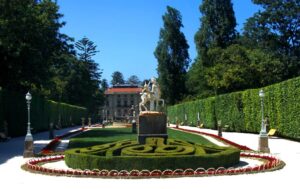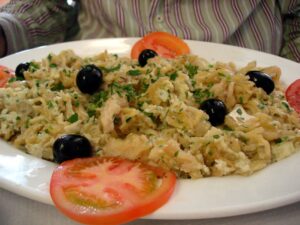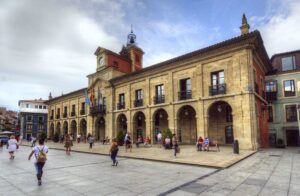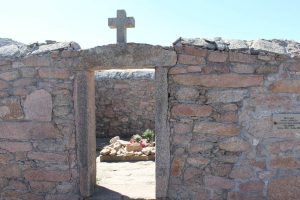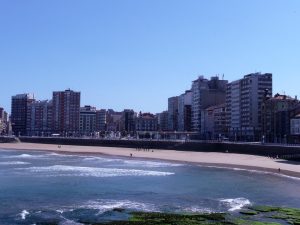Roncesvalles, also known as Orreaga, is a jewel nestled in the Navarrese Pyrenees, a meeting place of cultures, stories and legends. With just 30 residents, this small town is not only a geographical landmark on the Camino de Santiago, but also a portal to a place full of traditions and spirituality.
Here, pilgrims arriving from Saint Jean Pied de Port find more than a well-deserved rest. They discover a world where time seems to have stopped and history comes to life in every corner. Whether you have planned your route with one of the travel companies for the Camino de Santiago de Compostela or you are going to go on your own, this Navarrese town will be, if not the starting point, a mandatory stop on your tour.
Índice de contenidos
Link with the Camino de Santiago
The Camino de Santiago, an ancient route that has attracted millions of pilgrims over the centuries, finds in Roncesvalles one of its most significant starting points. Although as we have told you, the French Way It starts in Saint Jean Pied de Port, Roncesvalles It is the first point of contact for this route in Spain.
Located just 27 kilometers from St. Jean-Pied-de-Port, this small town is chosen by many to begin their pilgrimage. It is the threshold of a journey of 780 kilometers which promises not only physical challenges but also a deep spiritual journey. There are not a few who venture to do the path from Roncesvalles by bike

Highlights and tourist attractions
Don’t let its small population fool you. In fact, as one of the best-known towns linked to the Camino de Santiago, it has a lot to offer.
The Collegiate Church of Santa María Roncesvalles
In the heart of Roncesvalles is the Collegiate Church, a majestic example of gothic art. This building, originally a hospital-monastery of the 12th century, is not only a place of worship, but also a time capsule that encapsulates the history and devotion of the region. Inside, the carving of the virgin It is a work of art that inspires peace and contemplation.
The Gothic cloister and chapter house
The cloister of the Collegiate Church and the Chapter House are testimonies of the artistic legacy of Roncesvalles. Here the Mausoleum of Sancho VII “the Strong” and the famous chains of Navarra tell stories of kings, battles and victories.
The Chapel of Saint James and Charlemagne’s Silo
This buildings, one dedicated to the apostle Santiago and the other to those who fell in the Battle of Roncesvalles, are vivid examples of the historical and religious importance of Roncesvalles.

Roncesvalles Museum
The museum houses valuable treasures such as Charlemagne’s Chess and the Miramamolín Emerald. Each object tells its own legend and has its historical meaning, intertwining reality and myth.
What to do in Roncesvalles?
As in practically all of Navarra, this picturesque town is nestled in a natural environment that has also been able to complement itself perfectly with the evolution of time.
Hiking and Nature:
- The Path of the Canons: This historic trail offers panoramic views of the collegiate church complex and tells the legend of Roland, the wounded knight.
- The Basajaunberro Forest: A circular route ideal for families, immersed in a landscape of beech and oak trees, where it is said that akelarres were held.
- The Route of the Burguete Bunkers: A journey through recent history along the border of the Pyrenees.

Cultural Exploration:
- Visit to nearby towns: Auritz/Burguete and Aurizberri/Espinal are living examples of Pyrenean culture, with cemeteries of funerary steles and distinctive architecture.
History and Culture
Roncesvalles is not just a town, it is a open history book. The Battle of Roncesvalles, in which Roland, Charlemagne’s nephew, suffered a fateful defeat, is just one of the many stories that have marked this place.
Every building, every stone, has a story to tell: from the exploits of kings and knights to the modest acts of faith of pilgrims over the centuries.
Tips for pilgrims
- Preparation for the Camino: Roncesvalles is the beginning of a long journey, through French Route of the Camino de Santiago, so it is crucial to be well prepared physically and mentally.
- Exploration and respect: Immerse yourself in the history and culture of Roncesvalles, but always with respect for its heritage.
- Proper clothing: Given the varied weather conditions, it is essential to wear clothing and footwear appropriate for hiking and changes in weather.
- Documentation and maps: Make sure you bring all the necessary documentation and Camino maps for a safe and enriching experience.
Roncesvalles is much more than a starting point on the French Way to Santiago. It is a place where history, culture and spirituality meet. Here, among its ancient monuments, its natural trails and the richness of its traditions, pilgrims and visitors will discover an unforgettable start to their journey.
This town not only marks the beginning of a path that will surely change your life. It is the beginning of a personal transformation, a place where each step is an encounter with history and an opportunity for reflection and inner growth.
Other Jacobean Routes that may interest you
Just as the French Way is one of the most popular, especially among those who arrive from other countries, the Portuguese Route to the Camino de Santiago de Compostela It is the second largest influx of pilgrims. It also has a shorter option, the Camino de Santiago from Tui, starting right from the border with Portugal.
You will also be able to see, in a map of the Northern Way, the route along the Cantabrian coast, an adventure full of stunning landscapes.
Likewise, if your plans are not to take such a long route, you can opt for the organized trip on the road to Santiago from Sarria, a pilgrimage as enriching and valuable as all those that take you to the Compostela Cathedral, but that you can do in less time.

